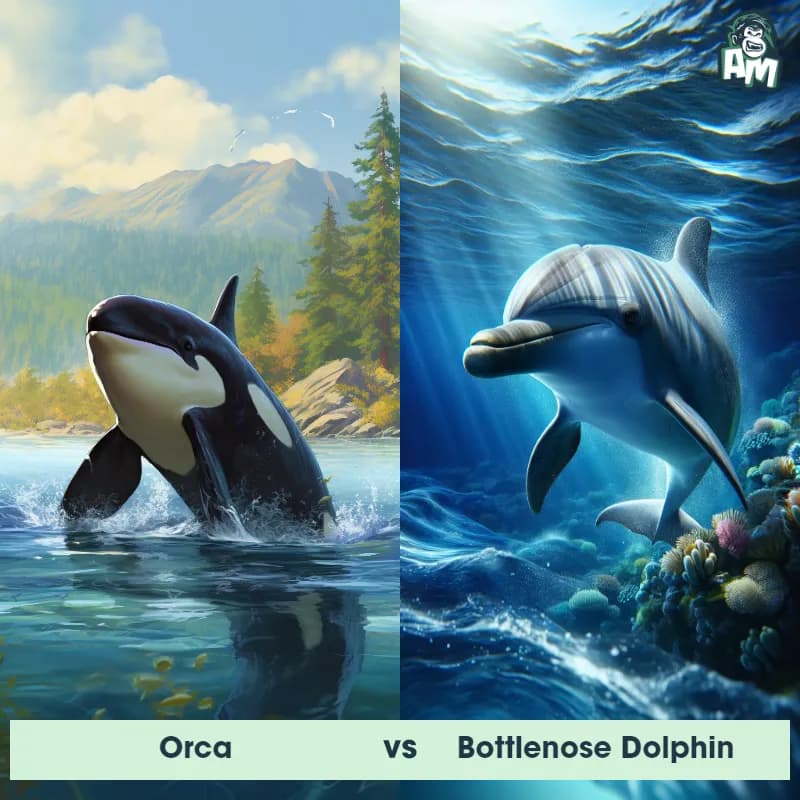Orca vs Bottlenose DolphinSee Who Wins

Ladies and gentlemen, welcome to this thrilling matchup between the mighty Orca and the nimble Bottlenose Dolphin! It's nature's ultimate face-off as these magnificent creatures go head-to-head in three intense rounds of aquatic combat. Let's dive right into the action!
Contender 1: Orca
The Orca, or killer whale, is a toothed whale belonging to the oceanic dolphin family. Known for their distinctive black-and-white coloration, orcas are among the most powerful predators on Earth. Adult males can grow up to 26 feet long and weigh up to six tons. They have a large dorsal fin, which in males can reach up to 6 feet in height. Orcas are found in oceans all over the world but are most common in the Arctic and the Antarctic. Their diet is diverse, including fish, seals, and even other whales.
Fun Fact: Orcas have a complex social structure, living in tight-knit family groups known as pods, and they are known to exhibit behaviors such as teaching, learning, cooperation, and grieving.
Contender 2: Bottlenose Dolphin
The Bottlenose Dolphin, scientifically known as Tursiops truncatus, is a highly intelligent marine mammal found in various oceans worldwide. Known for their sleek and robust bodies, they have a grayish coloration on their dorsal side that fades into a lighter shade on their ventral side. These dolphins have a distinct beak, called a rostrum, which gives them their common name. With a keen sense of hearing and communication through clicks, whistles, and body language, they can navigate and socialize effectively in their marine environment. Their playful nature and acrobatic displays, such as breaching and bow-riding, make them a popular sight for wildlife enthusiasts.
Fun Fact: One interesting fact about Bottlenose Dolphins is that they possess a complex social structure, living in groups called pods that can consist of up to 15 individuals but may occasionally join forces to form larger groups of hundreds or even thousands of dolphins.
Matchup Stats
| Orca | Bottlenose Dolphin | |
|---|---|---|
| Size | Up to 26 feet long (7.9 meters) | 10-14 feet (3-4.3 meters) |
| Weight | Up to 6 tons (5,443 kilograms) | 600-1,400 pounds (272-635 kilograms) |
| Speed | 35mph (56km/h) | 22mph (35.4km/h) |
| Key Strength | Powerful predator with strong jaws and sharp teeth | Intelligence and agility |
| Biggest Weakness | Limited mobility on land | Lack of physical power |
Current Votes
Orca vs Bottlenose Dolphin
See Who Wins
View More Matches
Looking For More?
Similar Matches
Scientific Stats
| Orca | Bottlenose Dolphin | |
|---|---|---|
| Scientific Name | Orcinus orca | Tursiops truncatus |
| Family | Delphinidae | Delphinidae |
| Habitat | Oceans worldwide | Marine |
| Geography | Global, most common in Arctic and Antarctic | Various oceans worldwide |
| Diet | Fish, seals, and other whales | Carnivorous, mainly fish and squid |
| Lifespan | 50 years - 80 years | 40 years - 50 years |
Key Differences between Orca and Bottlenose Dolphin
- Size: Orcas, also known as killer whales, are significantly larger than bottlenose dolphins, with adult male orcas reaching lengths of up to 32 feet and weighing up to 6 tons, while adult bottlenose dolphins typically reach lengths of 10-14 feet and weigh around 1,000 pounds.
- Teeth: Orcas have large, interlocking teeth that are conical and can grow up to four inches long. Bottlenose dolphins, on the other hand, have slender, cone-shaped teeth that are around one inch long.
- Coloration: Orcas have a distinctive black and white coloration, with a black upper body and white undersides, as well as white eye patches. In contrast, bottlenose dolphins have a more uniform grayish color, with a darker back and lighter belly.
- Habitat: Orcas are typically found in colder oceanic regions such as the Arctic and Antarctic, as well as all major oceans. Bottlenose dolphins prefer warmer coastal and offshore waters, including the tropics and subtropics, and can frequently be found near shorelines.
- Dorsal Fin: The dorsal fin of an Orca is much larger and more upright, often reaching heights of up to six feet in males, while the dorsal fin of a bottlenose dolphin is smaller and more curved, reaching heights of around one to two feet.
- Head Shape: Orcas have a more robust and rounded head compared to the more elongated and pointed head of bottlenose dolphins.
































